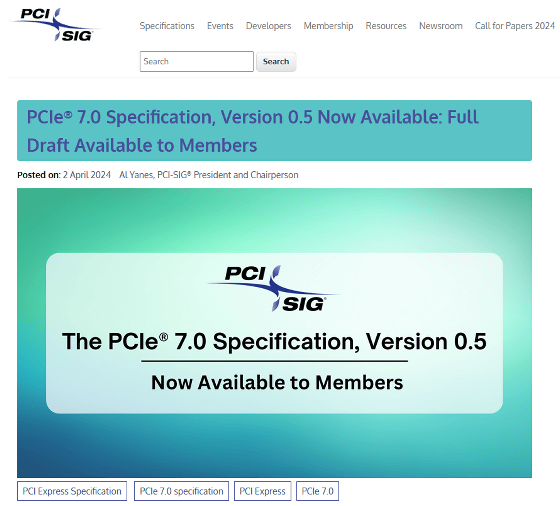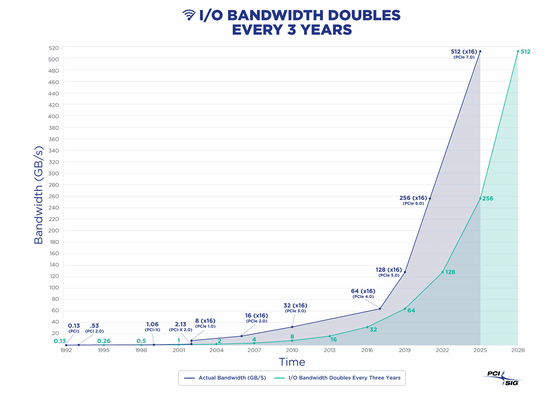PCIe 7.0 Provisional Specification Version 0.5 Released, Achieving Data Transfer Speeds of Up to 512GB/s

PCIe® 7.0 Specification, Version 0.5 Now Available: Full Draft Available to Members | PCI-SIG
https://pcisig.com/blog/pcie%C2%AE-70-specification-version-05-now-available-full-draft-available-members

PCI-SIG aims to finalize the PCIe 7.0 specification by 2025, and released the provisional specification ' Version 0.3 ' on January 10, 2023. Then, on April 2, 2024, the provisional specification 'Version 0.5' was released, appealing that work is progressing smoothly toward finalizing the specification in 2025.
The PCIe 7.0 Provisional Specification Version 0.5 has a data rate of up to 128GT/s and a bidirectional transfer rate of up to 512GB/s in a 16-lane configuration, inheriting the initial specification announced in 2022. It also inherits features such as 'use of PAM4 signals,' 'focus on channel parameters and reach,' 'combining low latency and high reliability,' 'improved power efficiency,' and 'maintaining backward compatibility with all previous generation PCIe standards.'
PCIe 7.0 is scheduled to be released in 2025, with data rates of up to 128GT/s and bidirectional transfer speeds of up to 512GB/s - GIGAZINE

Below is a graph showing the transition of the maximum transfer speed of the PCIe standard. You can see that the maximum transfer speed has doubled every time a new PCIe standard appears.

Although the specifications for PCIe 6.0, the previous generation of PCIe 7.0, are scheduled for 2022, at the time of writing, PCIe 5.0-compatible SSDs are just beginning to become popular, and even the GeForce RTX 4090, which has the highest performance among commercially available graphics boards, is not making full use of PCIe 4.0 .
In addition, overseas media AnandTech points out that 'Unlike PCIe 6.0, which doubled the bus frequency by improving signal processing, PCIe 7.0 requires doubling the bus frequency at the physical layer. For this reason, it will be difficult to develop devices that support PCIe 7.0. For this reason, even if the PCIe 7.0 specification is finalized in 2025 as scheduled, it will likely be quite some time before compatible products appear.
Related Posts:
in Hardware, Posted by log1o_hf






